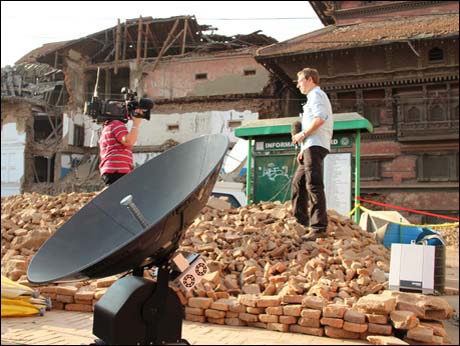
July 22 2015: Leading global mobile satellite communications services provider -- Inmarsat -- is poised to put in place the world’s first globally available, high-speed mobile broadband service, delivered through a single network operator.
The $1.6 billion programme Global Xpress -- offers the prospect of a new Internet of Everywhere, on land, at sea and in the air -- a seamless morphing of satcom and broadband delivering data speeds 100 times faster than hitherto possible by satellites alone.
Public and private sectors, will be able to significantly enhance their connectivity and 'illumine' even in the remotest and most inaccessible regions of the world. While the 3rd Global Xpress satellite is yet to be launched the system has already proven itself in critical disaster situations -- the last being the Nepal earthquake earlier this year.
Global Xpress terminals are larger than the backpack-sized Broadband Global Area Network (BGAN) or pocket-sized IsatHub terminals, already offered by Inmarsat and deployed in large numbers. They are however extremely portable, and much more compact than standard VSAT terminals, making Global Xpress a natural fit for first responder agencies like emergency relief organizations.
Global Xpress (GX) Ka-band service and its Inmarsat-4/Alphasat, L-band constellation were able immediately to assist first responders and media organisations in Nepal, following the tragic earthquake in April, explained Tim Johnson Vice President Channel and Portfolio Development, Inmarsat Enterprise. The GX service and the Inmarsat-4/Alphasat constellation were crucial in providing support to rescue coordinators and media on the ground in two ways, he said:
Firstly, working closely with with Télécoms Sans Frontières, IsatPhone Pro satellite telephones were used to enable affected populations to make voice calls. BGAN terminals were also deployed to provide relief organisations and coordination centres with reliable satellite connections, which allowed the agencies to assess the impact of the disaster and begin to formulate a plan to restore the telecoms and other infrastructure of the area.
Secondly, Inmarsat sent two of their own engineers to Nepal to provide media on the ground with technical support for our new high bandwidth Global Xpress service. The two engineers also carried IsatPhone 2 satellite phones, which were programmed to report their position each hour into a tracking application called GSatTrack from Inmarsat Certified Application Partner, Global Satellite Engineering. This safety mechanism allowed the London management team to follow the whereabouts of their engineers at regular intervals; something that was crucial to ensuring that, with continuing aftershocks, the engineers could be located if they missed a daily report schedule.
How was BGAN used to create an ad hoc WiFi environment within a smaller area? The emergency telecoms NGO TSF immediately set up camp at Kathmandu International Airport, alongside Urban Search and Rescue (USAR) teams from across the world, to deploy a high-speed Inmarsat BGAN satellite internet connection. BGAN’s voice and data connectivity service allowed rescue teams from across the globe, to carry out situation analyses, allocation of assignments and disaster mapping, enabling a rapid and efficient co-ordination of resources and initiatives to quickly reach those trapped in the rubble, and begin to assess the work needed to restore basic food, water, power and other services to those affected.Using BGAN, TSF established Wi-Fi facilities within the camp that ensured the Off-Site Operation Coordination Centre (OSOCC) dedicated to Search and Rescue could coordinate life-saving relief efforts.
Such a combo of satellite and broadband networks seems likely to play significant role in the recovery, rebuilding and development of communities following a disaster. From eHealth and eEducation, to the provision of high-speed global mobile internet access for media around the world to galvanise awareness of a disaster situation, Global Xpress and similar services can be deployed in times of need, anywhere in the world.
“This is a truly transformational technology and, as we complete its global roll-out, 2015 promises to be one of the most significant chapters in our company’s history", says Inmarsat CEO Rupert Pearce.
See our Image of the Day picture story on Satellite communication and broadband technologies in disaster situations.
----------------------------------------------------------------------------------------------------------------------------------------------------------------------------------------------
India: Satellite telephony regulations
Anyone wishing to carry a satellite phone into India, needs to first obtain a licence.
Satellite phones are permitted only with specific permission from Department of Telecomm, Government of India. Presently use of specific type of INMARSAT terminals are only permitted as per details available under the link INMARSAT.
Tata Communications Ltd (TCL) is permitted to provide Inmarsat services in India under their International Long Distance(ILD) licence granted by Department of Telecommunications(DoT).
Any individual/ public/ private sector companies/ autonomous bodies/ Government departments etc. can apply for issue of No Objection Certificate for use of INMARSAT terminals
INMARSAT Satphones excluding BGAN system can be used by the government, corporate houses, members of mountaineering expeditions and other such categories with prior permission from the DoT.
Thuraya Satphone service is not permitted in India. Anyone using a satellite phone without prior permission of DoT violates the Indian Telegraph Act and can be penalised under that Act.
Such phones being brought in baggage/hand baggage are liable to confiscation/detention in the absence of a license from the DoT. The No Objection Certificate for carrying a satphone into India is issued by the DoT on a case by case basis.
----------------------------------------------------------------------------------------------------------------------------------------------------------------------------------------------